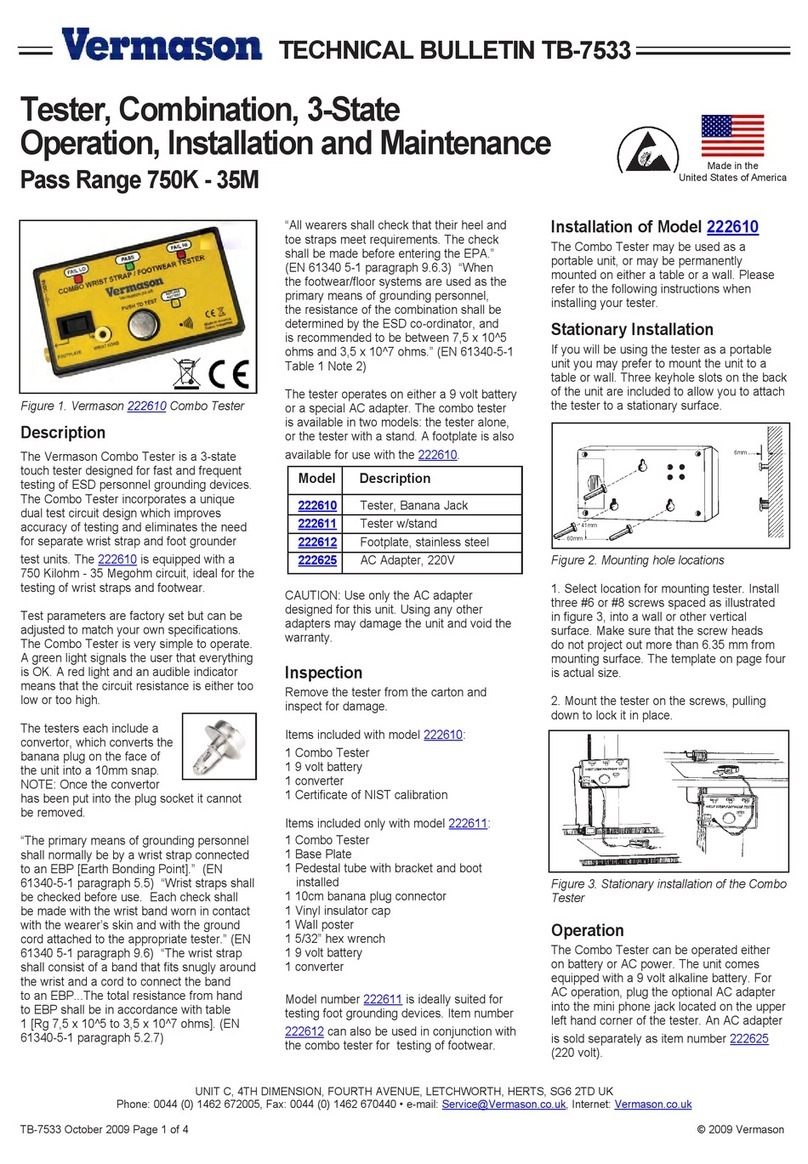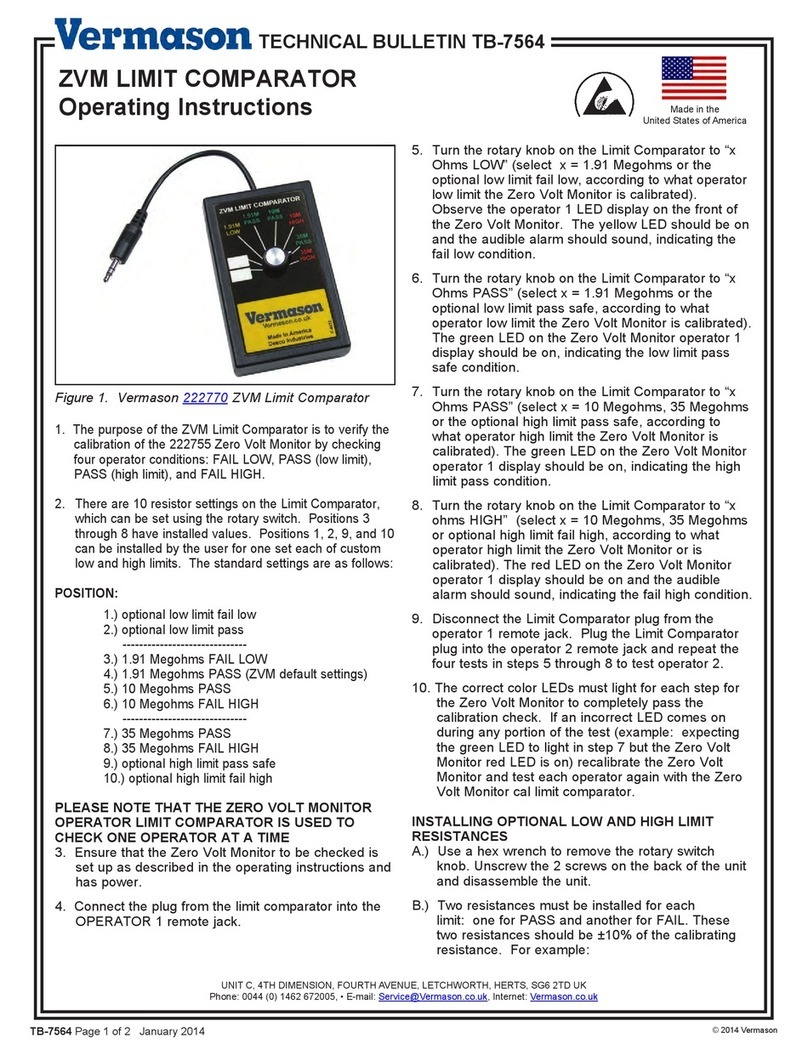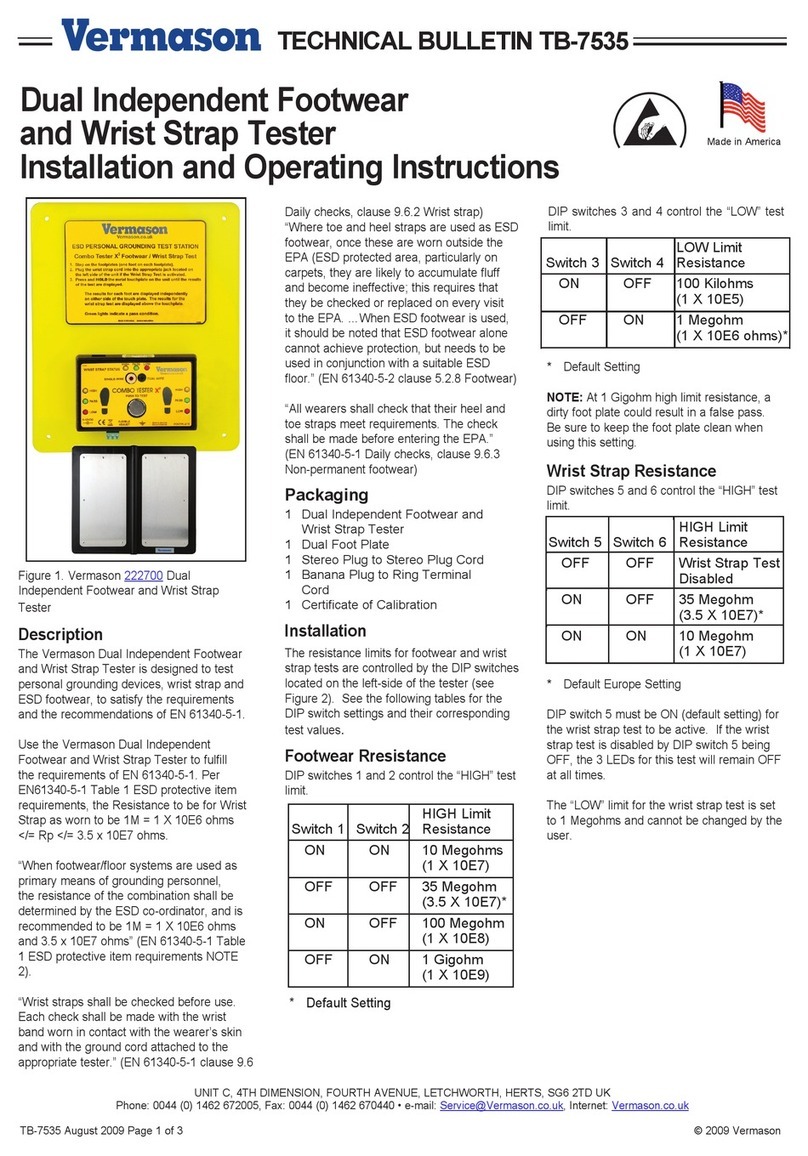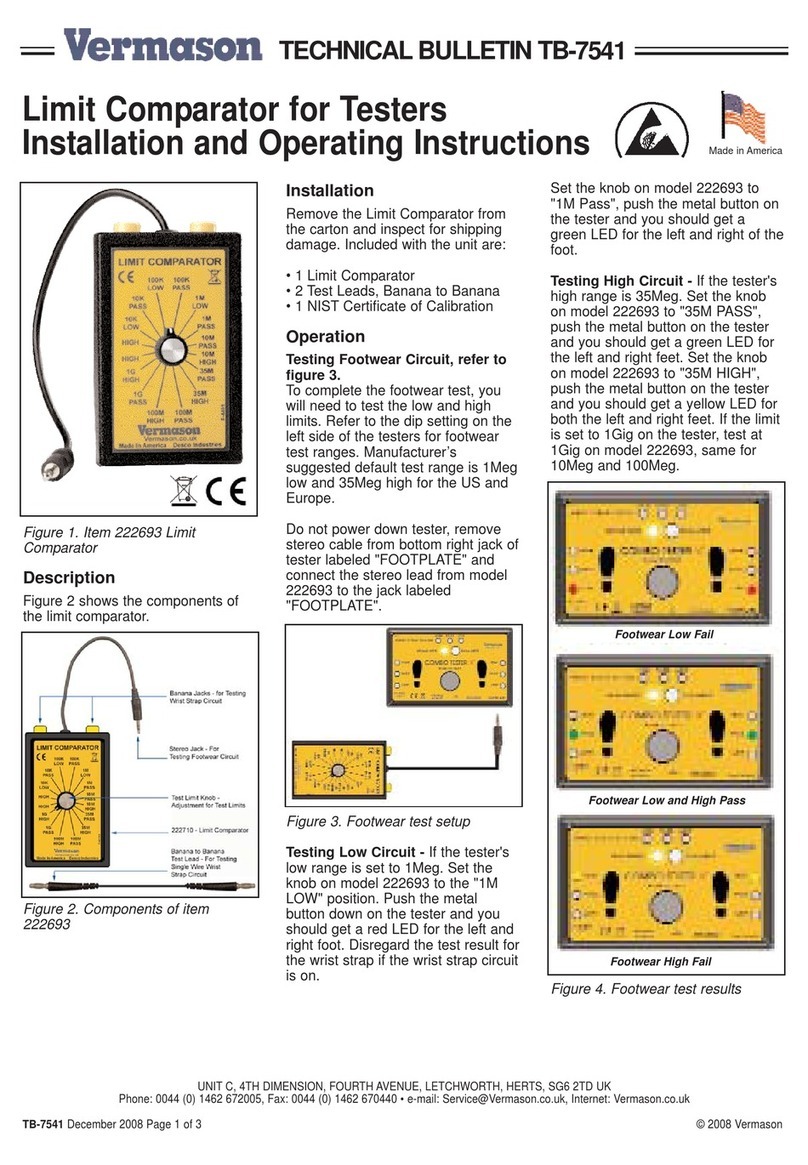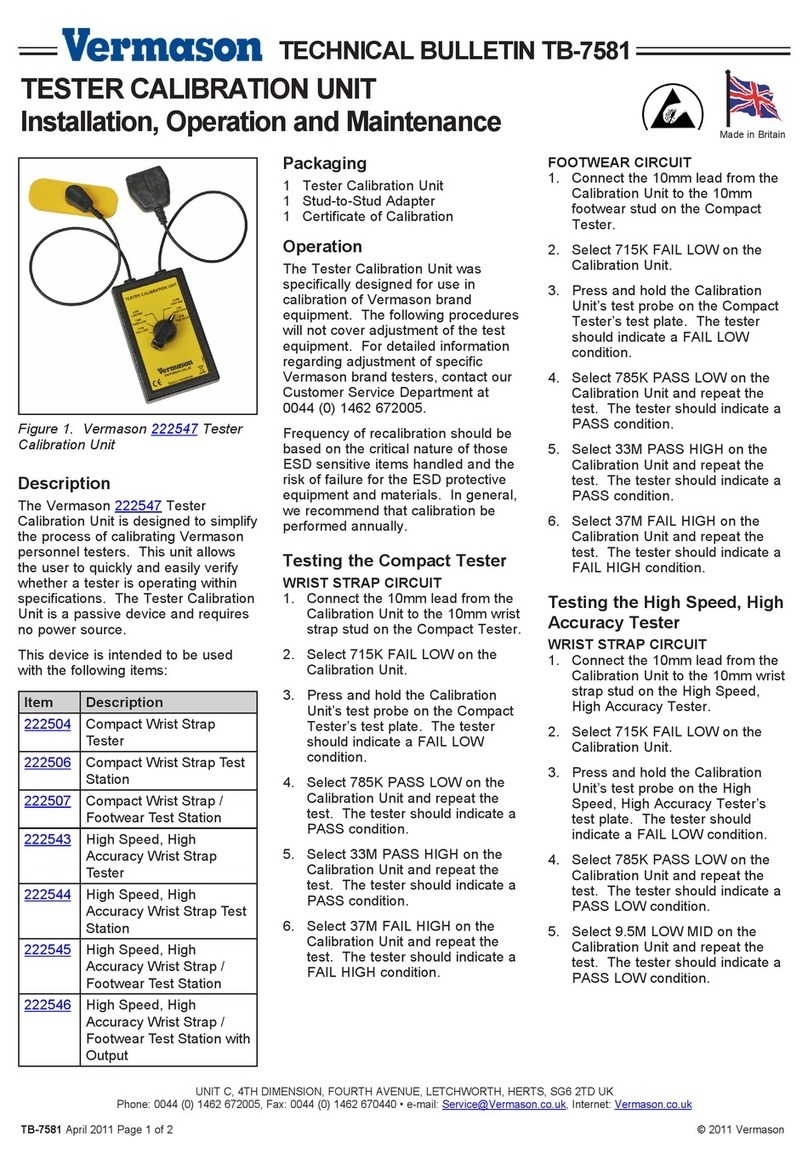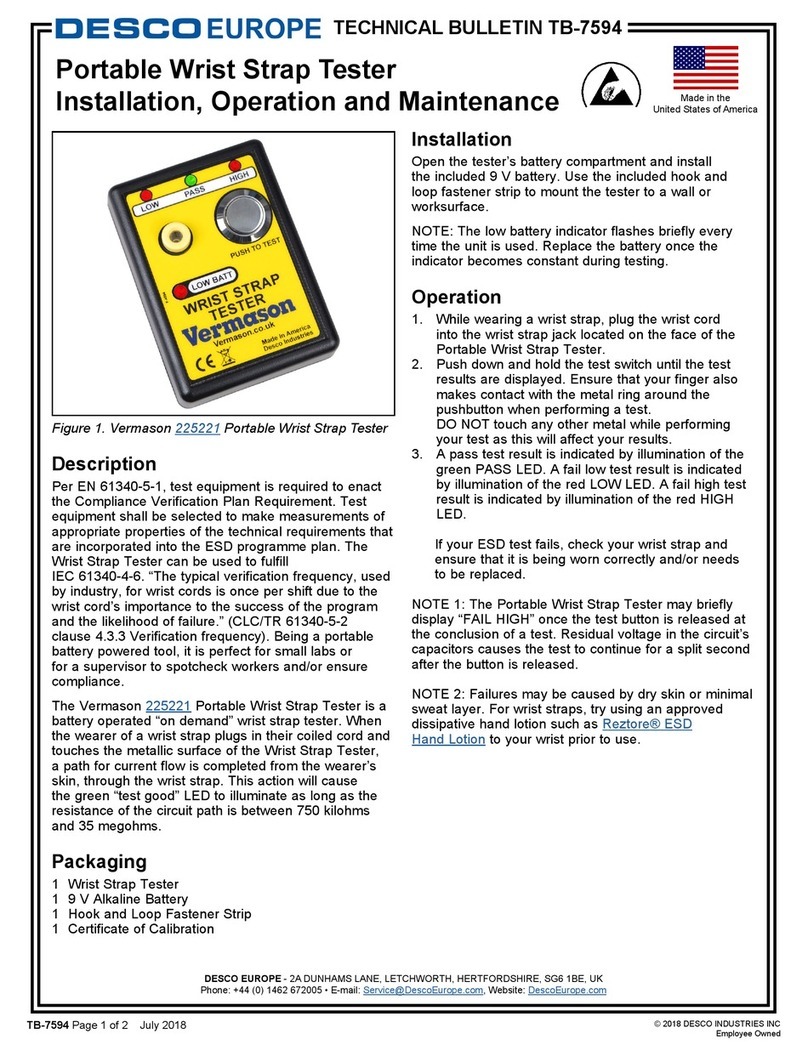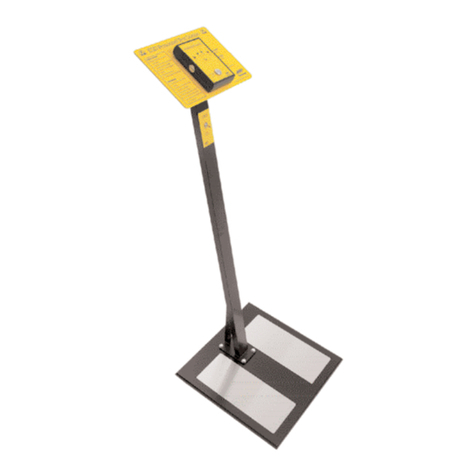
TB-7545 Page 3 of 6 © 2012 VERMASON
UNIT C, 4TH DIMENSION, FOURTH AVENUE, LETCHWORTH, HERTS, SG6 2TD UK
Phone: 0044 (0) 1462 672005, Fax: 0044 (0) 1462 670440 • E-mail: Service@Vermason.co.uk, Internet: Vermason.co.uk
F. AA Battery Compartment.
G. Resistivity Parallel Attachment with Electrodes. (optional
Item number 222632)
Cleaning
Clean the conductive pads of electrodes with a minimum
70% isopropanol-water solution.” Make sure they are dry
prior to use.
See specific product test standard for laboratory test
specimen cleaning instructions. Generally, the test
specimens and electrodes should be cleaned twice with a
minimum 70% isopropanol-water solution using a clean,
low-linting cloth each time.” (Note: then conditioned for 72
hours, minimum)
For installed product periodic audits, do not clean surfaces.
However, if any measurements lie outside the acceptable
range, clean the surface and re-test. (Note: for working
surfaces, use Vermason Reztore™ Antistatic Surface
and Mat Cleaner (item 229020) or other ESD cleaner not
containing silicone. Be sure the surfaces dry before testing.
Periodic maintenance - The area surrounding the cable jacks
at the top end of the meter should be wiped with a clean
cloth moistened with alcohol to remove skin oils that will
accumulate and affect the accuracy at high resistances. The
frequency of cleaning will depend on usage; once a month
would be a good starting point. Other items that should
also be cleaned in this fashion are the cable jackets and the
resistivity attachment, if included.
Power Requirements
The Meter is powered by two replaceable alkaline AA
batteries.
Test Procedure
General Guidelines:
• Use both 2.27 Kg Electrodes for Rg
• Use one 2.27 Kg Electrode with lead to grounded EPA
bonding point for Rp (note: EPA bonding points are usually
snaps installed on the material or workstation)
• Use optional Resistivity Attachment (removing leads &
Electrodes) for Resistivity measurements
• Ensure that item being measured is electrically isolated
(i.e. placed on an insulative surface) or Meter may
measure lower resistance path. Lay item on an insulating
support (>10E12 ohms) avoiding contact with the table.
• Ensure that test leads are separated or Meter may
measure lower resistance path
• When using 2.27 kg Electrodes:
• Place no closer than 5 cm from edge of surface being
measured
• Place no closer than 7 cm to any EPA bonding point
• Place 2.27 kg Electrodes about 25 cm apart for Rp
• Preferred placements include: most commonly used
surface portion, most worn, center, furthest from EPA
bonding point.
• For Rg, connect the sensing lead with shielded plug to
grounded EPA bonding point
• If surface has sections (like floor tiles or garment panels),
for Rp place a 2.27 kilogram electrode on different sections
• Clean surface for Laboratory test, but do not initially clean
surface for installed products (if fails, clean and retest)
Laboratory Test Procedure Guideline
For laboratory test of ESD Working surfaces, Floor Materials,
Footwear, Garments, or Seating, best advice is to follow test
methods of Annex A of EN 63140-5-1.
• The test specimens and electrodes should be cleaned
twice with a minimum 70% isopropanol-water solution
using a clean, low-linting cloth each time)
• Environmental chamber (Control relative humidity to 12
±3% RH and 50 ±3% RH and temperature to 23 ±2° C)
• Specimen support surface (greater than 1012 ohms such as
PMMA, PTFE or polycarbonate)
• Specimen Pre-Conditioning (23 ±2 degrees C; 3
specimens at 12 ±3% relative humidity for up to 48 hours
minimum, and 3 specimens at 50 ±3% relative humidity for
up to 48 hours minimum
• Measurement of point-to-point resistance shall be
performed according to 2.1.2.3 of IEC 61340-4-1 in a
minimum of three locations for point-to-point resistance,
and a minimum of one location per square metre for
large areas for qualification testing, for surface-to-EPA
ground resistance. Care shall be taken to include, when
applicable, resistance between separate tiles.
• Reporting Test Results
• Minimum, median and maximum readings for both
resistance-to-ground and point-to-point resistance in ohms
at low relative humidity
• Minimum, median and maximum readings for both
resistance-to-EPA bonding point and point-to-point
resistance in ohms at moderate relative humidity
• Temperature
• Relative humidity
• Actual duration of conditioning
• Test equipment used
Periodic Audit of Installed Product Test
Procedure Guideline
Measure Rg Resistance to Ground
Test Procedure:
• The material shall be tested without cleaning of the surface
with liquid cleaning agents. Loose dust may be removed
by gentle brushing or by blowing with clean, dry air.
• Remove from the surface only those items that might
interfere with the test.
• ESD sensitive devices shall also be removed
• Clip the sensing test lead with shielded plug to grounded
EPA bonding point
• Use one 2.27 kg Electrode on other test lead and place
Electrode the farthest convenient point on the surface
• Press button and hold Test Button until measurement is
displayed
• Perform additional measurements placing Electrode on the
most commonly used or most worn area

